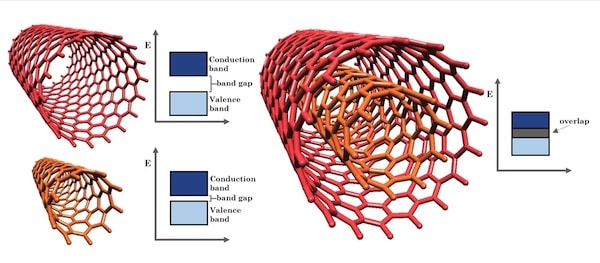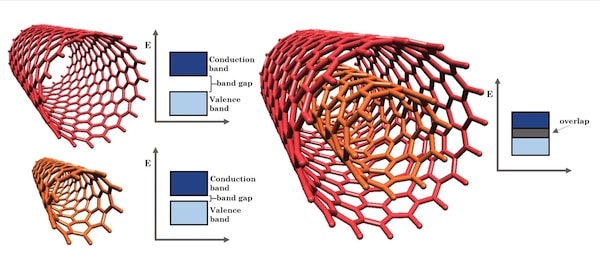
Last week we cited research reporting an efficient method to remove metallic single-walled carbon nanotubes from semiconducting single-walled carbon nanotubes, among other purposes, to facilitate studies of thin film transistors. Other researchers at Rice University have recently shown by extensive theoretical studies that it may be possible to tune double-walled carbon nanotubes for specific electronic properties, including those important for nanotube transistors. A hat tip to Kurzweil Accelerating Intelligence for an overview of this work and linking to this Rice University news release written by Mike Williams “Nanotubes with 2 walls have singular qualities“:
Rice University researchers have determined that two walls are better than one when turning carbon nanotubes into materials like strong, conductive fibers or transistors.
Rice materials scientist Enrique Barrera and his colleagues used atomic-level models of double-walled nanotubes to see how they might be tuned for applications that require particular properties. They knew from others’ work that double-walled nanotubes are stronger and stiffer than their single-walled cousins. But they found it may someday be possible to tune double-walled tubes for specific electronic properties by controlling their configuration, chiral angles and the distance between the walls.
The research reported in Nanotechnology was chosen as the journal’s “publisher’s pick” this month. The journal also published an interview with the study’s lead author, Rice graduate student Matías Soto.
Carbon nanotubes, grown by various methods, come in two basic varieties: single-walled and multiwalled (those with two or more walls). But double-walled tubes hold a special place in the hierarchy because, the researchers wrote, they behave somewhat like single-walled tubes but are stronger and better able to survive extreme conditions.
The Rice team found there’s even more to them when they started looking at how the inner and outer walls match up using tubes with zigzag chirality. Because the electrical properties of single-walled tubes depend on their chirality – the angles of their hexagonal arrangement of atoms – the researchers thought it would be interesting to learn more about those properties in double-walled tubes.
“We saw that the interwall interaction could affect the electronic properties of double-walled carbon nanotubes and decided to study this effect in a more systematic way using computational simulations,” Soto said.
It turned out that both the distance between the walls — as small as a fraction of a nanometer — and the individual chirality of the tubes impact the double-walls’ electrical properties. In addition, the researchers found the diameter of the tube — especially the inner one, with its more pronounced curvature — has a small but significant impact on the structure’s semiconducting properties.
Breaking it down further, they determined that semiconducting nanotubes wrapped around metallic, highly conductive nanotubes could be the best candidates for tuning the band gap, the property that defines the value of a semiconductor.
“The most interesting thing we found was that when you combine a metallic with a semiconductor, the band gap depends on the distance between them,” Soto said.
It’s not yet possible to do so, but the ability to adjust the distance between walls may lead to nanotube transistors, he said.
Other nanotube configurations may be best for turning into macroscopic carbon nanotube conducting wires, particularly with metallic-metallic nanotubes, the researchers found.
These computational results demonstrate the complex factors that can impact carbon nanotube performance for a wide range of applications. We can hope that this computational trail-blazing will shorten the path to implementing and commercializing these applications.
—James Lewis, PhD
